Lot may have been out of sight, but he was not out of Abram’s mind and heart. This devotional reading looks at Abram’s response to Lot being carried off after a suppression of a rebellion.
Nuggets
- Kedorlaomer (Cherdorlaomer) was King of Elam.
- The Cities of the Plains had been under the rule of King Kedorlaomer (Cherdorlaomer).
- In the 13th year, five kings, most descendants of Canaan, rebelled against Kedorlaomer.
- Those not in the fight also feel the effects of war.
- Uncle Abram went to the rescue.
- Abram didn’t let past history affect his desire to rescue Lot.
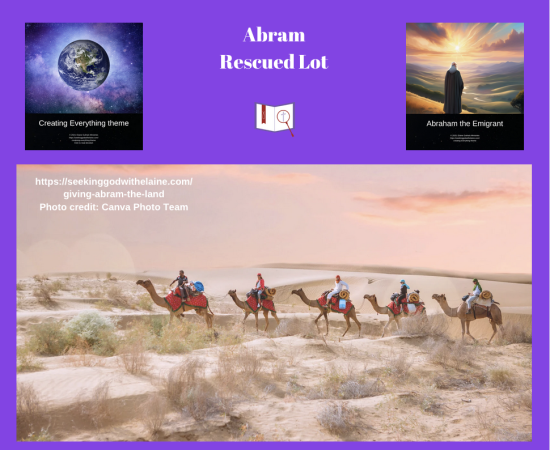
We aren’t told when Lot and Abram separated, but sometime between 1880 and 1875 BC the events of Genesis 14 take place. Rebellion takes place that spews over onto Lot and then Abram.
Let's Put It into Context
To read devotions in the Creating Everything theme, click the button below.
Devotions in the Abraham the Emigrant series
War
“About this time war broke out in the region. King Amraphel of Babylonia, King Arioch of Ellasar, King Kedorlaomer of Elam, and King Tidal of Goiim fought against King Bera of Sodom, King Birsha of Gomorrah, King Shinab of Admah, King Shemeber of Zeboiim, and the king of Bela (also called Zoar). This second group of kings joined forces in Siddim Valley (that is, the valley of the Dead Sea). For twelve years they had been subject to King Kedorlaomer, but in the thirteenth year they rebelled against him” (Gen. 14: 1-4 NLT)
Kedorlaomer (Cherdorlaomer) was King of Elam.
Before we talk about the situation discussed in the beginning of Genesis 14, we need to talk about the kingdom of Elam. It was located in what is currently southwestern Iran from 2700 BC to 539 BC.
We know cities and kingdoms are named for individual people. This is no different.
Elam was the son of Shem. “The descendants of Shem were Elam, Asshur, Arphaxad, Lud, and Aram” (Gen. 10: 22 NLT).
War Broke Out
The Cities of the Plains had been under the rule of Kedorlaomer (Cherdorlaomer), King of Elam.
We don’t know why the Cities of the Plains were invaded in the first place. We just know that 12 years earlier, the five city came to be under the room of the King of Elam. (We don’t know how long Kedorlaomer had been ruling.)
Gray made an interesting observation. He said that the marauding chieftains came from the Plain of Shinar. Yep. That was where they tried to build the Tower of Babel.
Resource
I know. The Tower of Babel was tied to Ham’s descendants, not Shem’s and Japheth’s.
But remember what we said in Genesis 11. All of Ham’s descendants, including Nimrod, were supposed to go to Africa, but they didn’t. Since the territory was supposed to be allotted to Shem, they probably did a hostile takeover.
When they were dispersed after the Tower of Babel fiasco, God probably allowed Shem’s line to stay in that area with Japeth’s descendants around Mt. Ararat.
Since Elam was Shem’s descendant, they would have remained in the area.
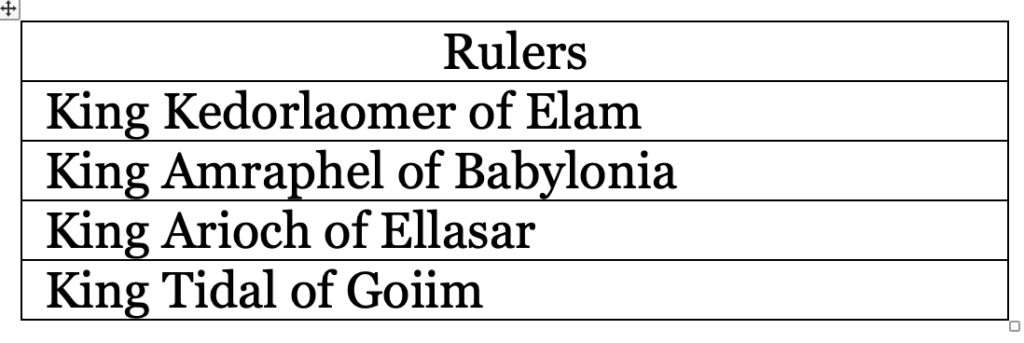
Let’s see who the rest of the players were.
A close ally would have been the king of Goiim. It is interesting that, in the Complete Jewish Bible, Tidal is the king of Goyim. That is the word used for Gentiles. “… K’dorla‘omer king of ‘Elam and Tid‘al king of Goyim” (Gen. 14: 1 CJB).
We talked about the Goyim – Gentiles – before. Japheth, Seth’s brother, was the forefather of the Gentiles.
“From these the coastland peoples of the Gentiles were separated into their lands, everyone according to his language, according to their families, into their nations” (Gen. 10: 5 NKJV).
We have to try to figure out what we are talking about when we talk about Babylon. Babylon was the capital of the ancient region of Babylonia. However, the term Babylonia also refers to the entire culture.
The region of Babylonia was developed in around 4000 BC. It rose to political prominence around 1850 BC,
It was located in southeastern Mesopotamia between the Tigirs and Euphrates Rivers. This is currently from Bagdad in southern Iraq to the Persian Gulf.
At one point, Babylonia was divided into two countries. They were Sumer and Akkad. That time was filled with constant fighting.
Still, many things came out of Sumer. The Sumerians were responsible for the first system of writing, called cuneiform. The Akkadians were responsible for inventing the potter’s wheel, sailboat, plow, and codes of law.
I couldn’t make heads or tails about Ellasar. I also couldn’t find anything beyond Zoar being a city. So, were the four other rebels descendants of Canaan?
Joined Forces in the Siddim Valley
In the 13th year, five kings, most descendants of Canaan, rebelled against Kedorlaomer.
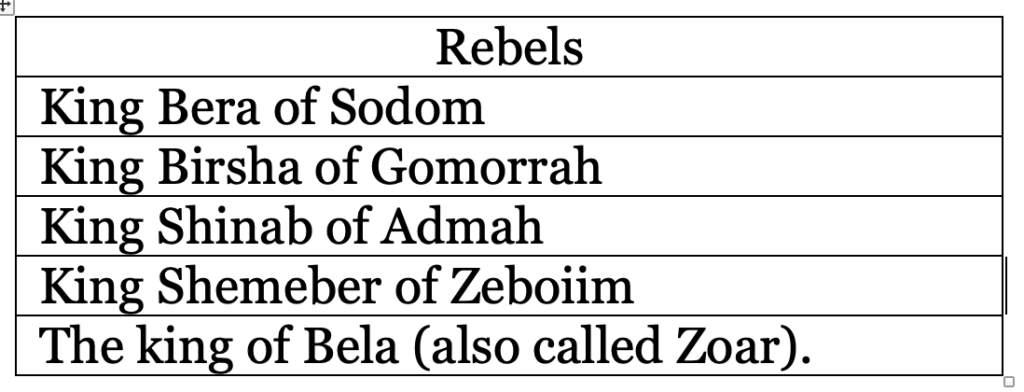
Yep, four of them were. “… The Canaanite clans eventually spread out, and the territory of Canaan extended from Sidon in the north to Gerar and Gaza in the south, and east as far as Sodom, Gomorrah, Admah, and Zeboiim, near Lasha” (Gen. 10: 18-19 NLT emphasis added).
Biblestudy.org’s Life of Abraham timeline notes that this incident happens around 1880 to 1875.
Resource
Think about this. How many times have we championed the freedom to govern ourselves? That is exactly what the rebels were trying to do.
Wilson agreed that it is par for the course. He wrote, “It is a reminder that there are moments in our lives when we must challenge the powers that oppress us, whether they be external forces or internal fears.”
Resource
But we can see Kedorlaomer’s desire to keep the territory that he would see as his. Ooo, baby. We don’t want to give up our stuff, do we?
Moses called the sea in the Siddim Valley the Yam HaMelach or Salt Sea. Regardless of bringing in a significant amount of fresh water each year, Williston told us that it remains the same level all year long.
Resource
We call it the Dead Sea. This is because the salt makes it so no fish can live within it.
The problem with the Siddim Valley was it was littered with tar pits. It was like a minefield. Those traversing it would have to pay attention.
Rebellion
“One year later Kedorlaomer and his allies arrived and defeated the Rephaites at Ashteroth-karnaim, the Zuzites at Ham, the Emites at Shaveh-kiriathaim, and the Horites at Mount Seir, as far as El-paran at the edge of the wilderness. Then they turned back and came to En-mishpat (now called Kadesh) and conquered all the territory of the Amalekites, and also the Amorites living in Hazazon-tamar. Then the rebel kings of Sodom, Gomorrah, Admah, Zeboiim, and Bela (also called Zoar) prepared for battle in the valley of the Dead Sea. They fought against King Kedorlaomer of Elam, King Tidal of Goiim, King Amraphel of Babylonia, and King Arioch of Ellasar — four kings against five. 10 As it happened, the valley of the Dead Sea was filled with tar pits. And as the army of the kings of Sodom and Gomorrah fled, some fell into the tar pits, while the rest escaped into the mountains. The victorious invaders then plundered Sodom and Gomorrah and headed for home, taking with them all the spoils of war and the food supplies. They also captured Lot — Abram’s nephew who lived in Sodom — and carried off everything he owned” (Gen. 14: 5-12 NLT)
Those not in the fight also feel the effects of war.
Kedorlaomer was on a roll. The fighting was going his way.
The fighting took place with the surrounding tribes first. I don’t know if this was an initial conquer or a preemptive conquer.
Whichever, they were then ready to take on the rebellious kings.
Again, Kedorlaomer and his coalition were victorious.
The last we heard, Lot left Abram and moved near Sodom. “… Lot moved his tents to a place near Sodom and settled among the cities of the plain” (Gen. 13: 12 NLT). Gray thought Lot had moved into Sodom by now.
That would be a bite. He wanted wealth and possessions, but here he was a captive stripped of his possessions.
Leale said that was the way things go. He wrote, “That men often suffer who take no part in the quarrel.”
Resource
I don’t think Jerdan agreed with Leale. He noted that, when Lot settled in the Jordan valley, the kings of the Pentapolis recognized Chedorlaomer, king of Elam, as their suzerain and paid him a yearly tribute. By moving there, Lot was saying that he was good with that and accepted it on his behalf.
Resource
True, the rulers in authority made the decision to rebel. But the underlings would have had to go along with the idea because — well — they were underlings. They didn’t always get a say in the matter.
Abram the Hebrew
“But one of Lot’s men escaped and reported everything to Abram the Hebrew, who was living near the oak grove belonging to Mamre the Amorite. Mamre and his relatives, Eshcol and Aner, were Abram’s allies” (Gen. 14: 13 NLT)
Uncle Abram went to the rescue.
It seems Abram had found a place to settle down. Abram is still living by this grove in Genesis 18: 1.
This is the first time that Abraham is called a Hebrew. Let’s look at in the Hebrew.
“And there came one that had escaped, and told Avram HaIvri …” (Gen. 14: 13 OJB).
It means to cross over. More literally, it means from the other side of the river.
This is true. Abram had to cross over from the other side of the Euphrates River to enter Canaan.
It is interesting that Moses listed three allies. It is nice to know Abram had allies in the area. God will put helpers in our path to accomplish His Will.

Abram the Warrior
“When Abram heard that his nephew Lot had been captured, he mobilized the 318 trained men who had been born into his household. Then he pursued Kedorlaomer’s army until he caught up with them at Dan. There he divided his men and attacked during the night. Kedorlaomer’s army fled, but Abram chased them as far as Hobah, north of Damascus. Abram recovered all the goods that had been taken, and he brought back his nephew Lot with his possessions and all the women and other captives.” (Gen. 14: 14-16 NLT)
Abram didn’t let past history affect his desire to rescue Lot.
Abram and Lot had parted ways because of a conflict. We think they parted on decent terms, but there may have been some residual resentment.
That didn’t stop Abram. He and his 318 fighting men took off to rescue Lot.
Abram didn’t need the numbers. He had God fighting with Him and for Him.
Up to this point, we haven’t seen Abram as a warrior. We’ve seen him as a worshiper.
But in that era, Abram had to have been at least a fighter. I doubt he would have survived if he didn’t know how to defend himself. Here, he was described more as a policeman.
Resource
But this was Kedorlaomer — the ruling power in those parts at the time. Abram as a private citizen had no right to wage war against a king.
Walking with God does not mean Abram was turned into a doormat. He wasn’t a conscientious objector.
God expects us to defend ourselves and our loved ones but also to submit to earthly authority.
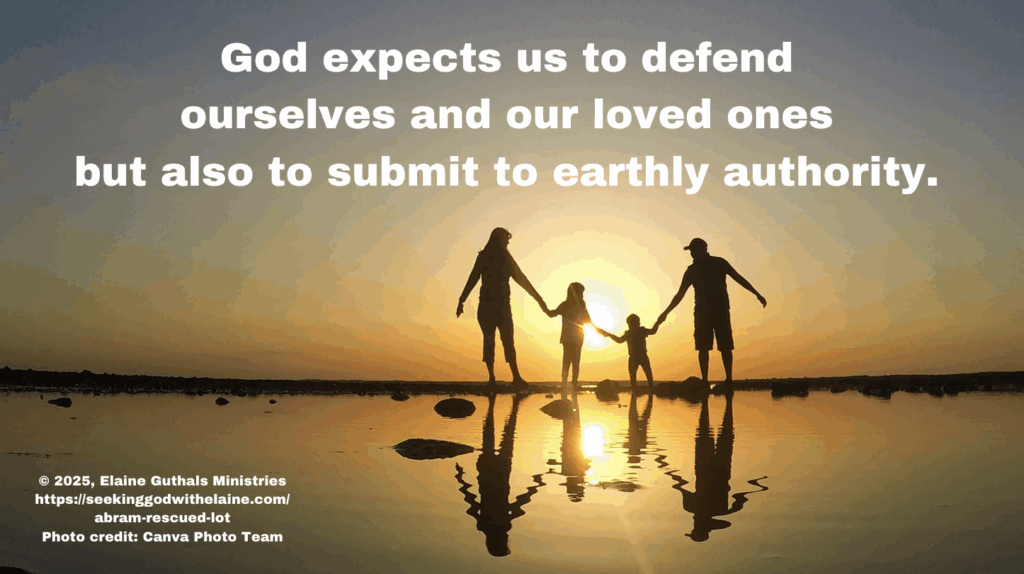
Now, whoever wrote this said that Abram caught whom he was pursuing at Dan. (Jerden thought that was Damascus.) This would have had to have been put into the account by someone other than Moses.
Not only had the Promised Land not been divided by the 12 tribes as they weren’t born yet, but also Moses didn’t go into the Promised Land. How would he know?
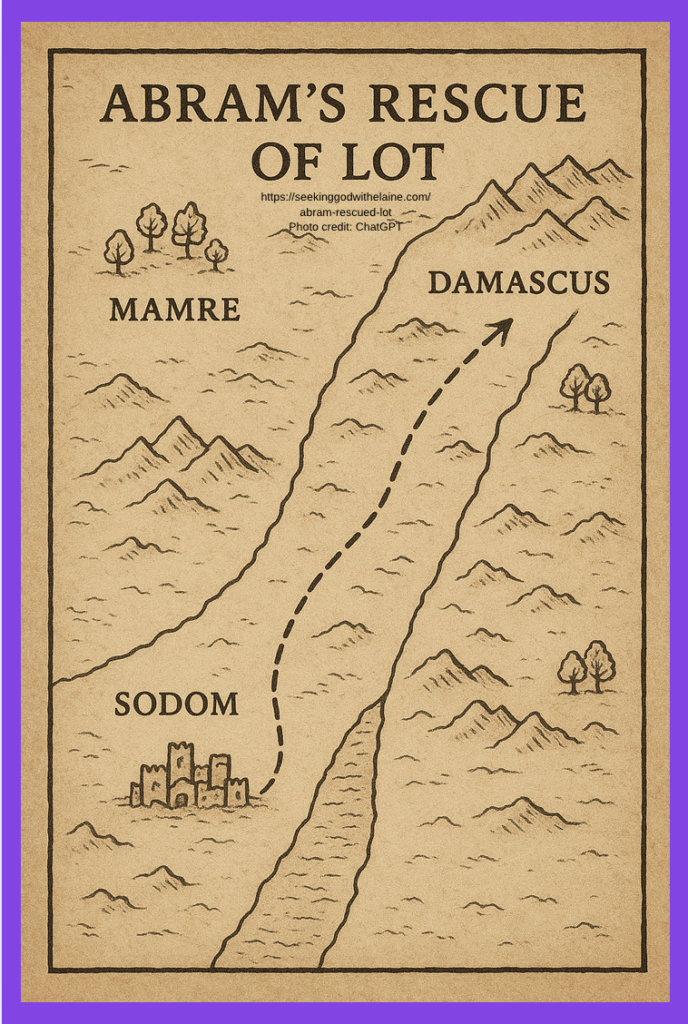
Abram did become a general in this instance. He knew enough about fighting to see the benefit of a nighttime offensive.
This tells me that, even though it sounds like they picked up and went after Lot without much notice, they were ready. They already had the training. They may have had a generic contingency plan for being attacked, defending themselves, etc.
Abram and his soldiers were ready.
Gray seemed to think that Abram killed the kings. We aren’t really told that here. Yes, it would make sure that it didn’t happen again.
But I wonder if Abram knew they were family.
That is a kicker, isn’t it? Abram was going to save family from family.
How many of us would have said Lot got his just deserts? Some of us may have left him to his fate.
Abram said, “Nope. I’m going after him.”
Making the Connections #1
There is a huge contrast between Kedorlaomer and Abram. Kedorlaomer probably did all his fighting with the motivation of greed, covetousness, and pride.
Abram on the other hand, went into this fight because of love. He loved his nephew, and he didn’t like to see how he and other innocent people were taken hostage.
So, Abram did something about it.
Making the Connections #2
I like what Gilfillan had to say. He wrote,
“Sometimes it is the Christian’s part to stay at home; and at other times to go far hence among the heathen. Sometimes it is his duty to sit under his family oak and attend to his family exercises; and at another time, like Abraham, to choose some post of peril, and do some good deed of daring.”
Sometimes, God calls us to stay put. Sometimes, He calls us to move. We have to do what we are called to do.
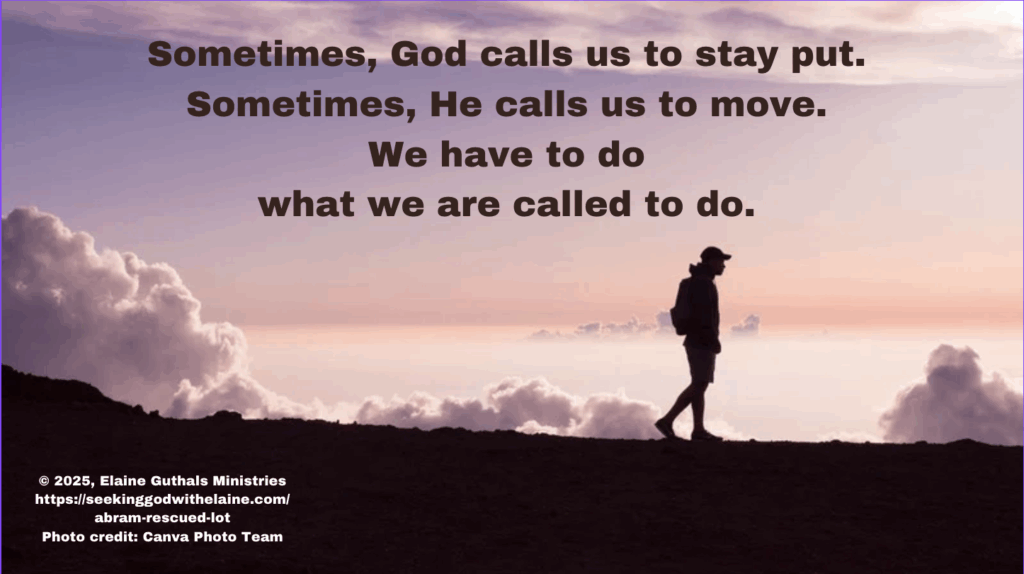
Making the Connections #3
Taylor pointed our that, though Abram was in the world, he wasn’t of it. He wrote, “In all this we have another illustration of the strength of Abraham’s faith. It kept him equally removed from ascetic seclusion on the one hand, and worldly conformity on the other.”
Resource
We are in the world. We can’t refuse all interaction with worldview people.
But we must not compromise our beliefs in order to get along with them. We have to say what God calls a sin remains a sin.
Does that mean we don’t fight the battles that are clearly worldly? Not when they are impacting someone who shares our faith. We must ride to the rescue immediately when God calls us to do so.
Making the Connections #4
Sometimes, valleys can be figurative in God’s Word. It may symbolize going through a trial. It can also remind us of a place of shelter and security, symbolizing God’s protection and provision.
How Do We Apply This?
- Watch so that ambition does not look to meet its own ends instead of God’s.
- Remember the wicked will persecute the faithful as well as other wicked people.
- Be ready when God calls.
- Be ready to come to another’s aid.
- Understand sin is a captivity and be prepared to rescue someone chained to it.
- Teach our children in God’s ways so they are ready to fight.
- Stand up to those oppressing our faith.
Resources
Father God. You have put us in a world that does not follow You. Because of that, Your children are many times in danger. Help us to keep our focus on You. Send loved ones to rescue us. Let us rescue our loved ones. Bring us home to You. Amen.
What do you think?
Leave me a comment below (about this or anything else) or head over to my Facebook group for some interactive discussion.
If you don’t understand something and would like further clarification, please contact me.
If you have not signed up for the email providing the link to the devotions and the newsletter, do so below.
If God has used this devotion to speak with you, consider sharing it on social media.